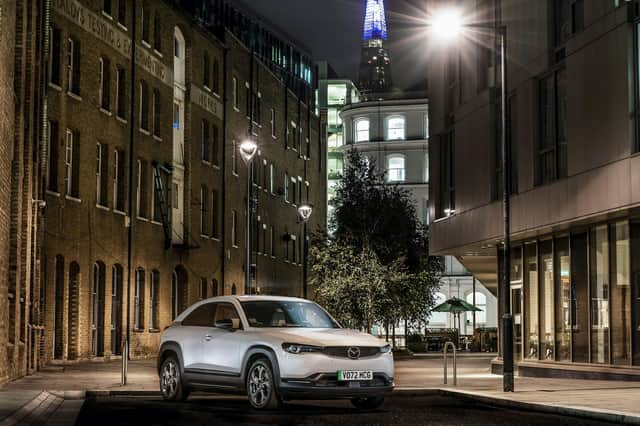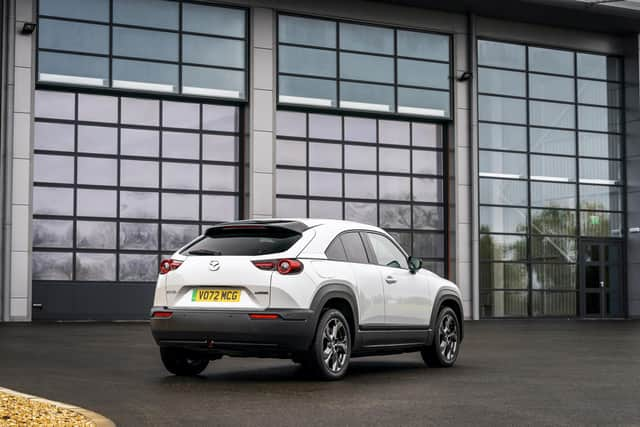Mazda: credit to a brand which doesn't go with the flow


Take the MX-5. This two-seater sports car launched in 1989 came at a time when such vehicles were regarded as old hat when compared with the big thing of the time, the hot-hatch.
But now MX-5 is still going strong and is in fact regarded as a modern classic.
Advertisement
Hide AdAdvertisement
Hide AdNow here comes another MX, the MX-30. It’s nothing like the MX-5 except it is strikingly different to anything else on the road. Unique in fact.


It is a plug-in hybrid that offers the same customer values as the pure electric MX-30, while simultaneously offering new ways of using a car as a battery electric vehicle.
With a 17.8kWh battery, the R-EV has a 53-mile pure electric range, and using Mazda’s unique rotary engine technology, the all-new 830cc single-rotor petrol engine acts as a generator to enable longer distance drives without range or charging anxiety.
With no mechanical connection between the engine and the wheels, the rotary unit simply acts as a generator, ensuring the MX-30 R-EV always drives via the electric motor to deliver a seamless EV driving experience.
Advertisement
Hide AdAdvertisement
Hide AdThe MX-30 R-EV proves to be a touch more refined to drive than its rivals, too. Rotary engines tend to be much smoother, quieter and more free-revving than the regular piston engines of most cars, which all helps in an otherwise silent electric vehicle.
Mazda also claims no drop-off in performance once the battery charge has dropped: the MX-30’s top speed of a modest 87mph is achievable whichever way the car is being powered.
It all sounds complex but the reality for the driver is much simpler. It feels like a conventional car but it offers exceptionally low emissions, high economy and as ever in a Mazda a good driving experience.
We took the car on a jaunt from Liverpool, through north Wales and back covering some wonderful twisty roads which suited the Mazda down to the ground.
Advertisement
Hide AdAdvertisement
Hide AdThis is Mazda’s first BEV (battery electric vehicle) production car.
Mazda say it is part of its “multi-solution approach” to creating efficient vehicles.
It features three generously equipped models – Prime-Line, Exclusive-Line and Makoto.
Standard equipment on all UK MX-30s includes LED headlights with daytime running lights, reversing camera, cruise control with “Intelligent Speed Assist”, navigation and head-up display.
Advertisement
Hide AdAdvertisement
Hide AdEach MX-30 comes as standard with a Type 2 AC charging cable and a socket for DC rapid charging, which allows for charging from 20 to 80 per cent battery in just 36 minutes.
The Mazda MX-30 range starts with the Mazda MX-30 Prime-Line, tested here which is marked out by 18in silver alloy wheels, black door mirrors and a black grille.
In a nod to Mazda’s founding as the Toyo Kogyo Cork Company in 1920, MX-30 features cork lined centre console trays and inner side door handles. Harvested from the bark of trees without felling, the use of cork and door trim materials that incorporate fibres from recycled plastic bottles, are suited to Mazda’s first pure electric production car.
Benefiting passengers and drivers alike, the sense of space is enhanced with a floating centre console that sits independently from the dashboard.
Advertisement
Hide AdAdvertisement
Hide AdFrom the outside, the MX-30 is distinctive. Two features stand out to me – the rear-opening rear doors and the sculpted rear lights.
The doors are designed to create easy access without the usual B-pillar which can be intrusive while the lights are simply a delightful design feature.
The front doors open forward to an angle of 82 degrees, while the rear doors open backwards to an angle of 80 degrees to reveal the stylish and driver focused interior.
The model tested also has regenerative braking (5 modes), powered and heated door mirrors, rain-sensing wipers and LED headlights and LED daytime running lights, plus 7in colour touch screen and a 7in colour driving display.
Advertisement
Hide AdAdvertisement
Hide AdFor quite a tall car, it feels balanced and has a sporty edge to it. Mazda say it is “an exciting start” to the company’s second century in business.
A spokesman said it has “distinctive styling, innovative technology, driver focused dynamics and class-leading interior quality”.
The three-model UK MX-30 line up forms part of an electrification strategy that has already seen Mazda M Hybrid, mild hybrid fitted as standard to the Mazda3, Mazda CX-30 and manual Mazda2s.
Heralding a new chapter in Mazda’s successful SUV history, the Mazda MX-30 joins the recently unveiled Mazda CX-60 with the marque’s first plug-in hybrid technology powertrain, Mazda M Hybrid mild-hybrid equipped Mazda CX-30 and recently updated 2022 Mazda CX-5 in Mazda’s comprehensive SUV line-up.
Advertisement
Hide AdAdvertisement
Hide AdThe car may offer a solution for customers who want an electric car for everyday usage but the flexibility to undertake longer journeys without the reliance on charging infrastructure.
Meanwhile, Mazda has unveiled a new compact sports car concept designed to celebrate ‘the joy of driving’.
Underneath, the Iconic SP uses what is believed to be a new incarnation of the electric-rotary system currently found on the MX-30 R-EV. The rotary petrol engine is used as a generator for the electric motor and batteries, rather than driving the wheels.
Though Mazda hasn’t stated full performance figures or outputs for the Iconic SP, it has said that it develops up to 370bhp while weighing just 1,450kg. Combined, these figures would make the SP the fastest car in Mazda’s current range and one of its most powerful models of all time.
Mazda MX-30 R-EV 170ps Prime Line
Price: £31,250 on the road for the entry-level model tested
Advertisement
Hide AdAdvertisement
Hide AdEngine: An 830cc single rotary petrol engine and an electric motor jointly emitting 170ps
Performance: Top speed 87moh and 0 to 60mph in 9.1 seconds
Range: electric range: 53 miles
Economy: 37.2mpg. Combined with electric 282.5mpg.
Emissions: 21g/km
Insurance: Group 19E
Warranty: Three years, 60,000 miles. Battery warranty is eight years, 100,000 miles